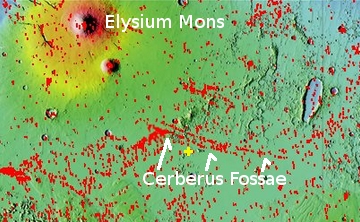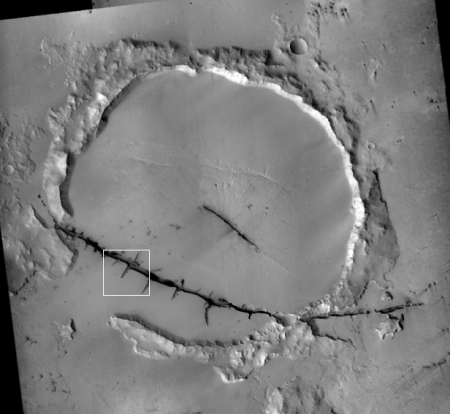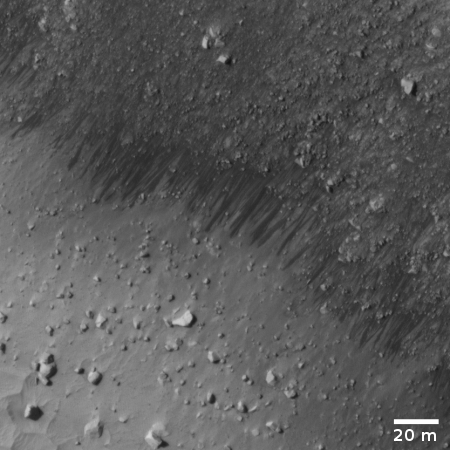A crack in the Martian crust

The photograph to the right, reduced and cropped to post here, was imaged on October 20, 2019 by the high resolution camera on Mars Reconnaissance Orbiter (MRO). It shows a spectacular thousand-foot-deep canyon in the region of Cerberus Fossae, an area of Mars crossed by numerous deep east-west fissures and depressions.
Hidden in the small white box on the eastern end of that canyon are Martian geological features, small and at first glance not that interesting, that are of great significance and the focus of intense research.
The map to the right shows an overview of the region. The yellow cross shows the location of this particular crack.
In my previous post about Cerberus Fossae, I had incorrectly assumed that these cracks and similar lines of pits or depressions were caused by the sinking of surface material into underground lava tubes. While this is possible in some cases, it is not the main cause of these cracks. Instead, they were formed due to the pressure from below caused by the rise of the surrounding giant volcanoes, Elysium Mons to the north and Olympus Mons to the east. That pressure stretched the crust until it cracked in numerous places. In Cerberus Fossae this produced a series of parallel east-west fissures, some more than seven hundred miles long.
The young age of Cerberus Fossae is dramatically illustrated by the wider mosaic below, showing the entire crack.

Mosaic made from images here, here, and here.
The crack cuts across and within an ancient and significantly eroded crater that appears to have been partly buried. From this we can guess the following sequence: First we had the impact. This was followed by extensive and massive lava flows that not only ponded within the crater but also were strong enough to cut through and destroy the southwest part of the crater rim.
Finally the ground bulged upward and cracked.
At first glance one could also assume this image was taken to track the canyon’s erosion as well as the possibility of avalanches and boulder falls on canyon’s steep cliffs, as was the case in my previous Cerberus Fossae MRO image post. That assumption would also be incorrect. The photograph was taken as part of a major monitoring program involving a completely different Martian geological feature, dubbed by planetary scientists with the very uninteresting name of recurring slope lineae or RSLs.
Lineae are important because they vary seasonally from year to year on steep slopes in the Martian mid-latitudes, growing during the summer and fading during the winter, behavior that strongly suggests the presence of melting liquid water.
David Stillman of the Southwest Research Institute in Colorado had requested this particular image as part of that monitoring program. He had wanted to see if the 2018 global dust storm had caused any changes to the lineae.

The image to the right shows the area indicated by the small white box in the first image above, but was taken in 2008 after an earlier dust storm. Then the lineae were distinct and obvious, as shown in this image,
After last year’s global dust storm, Stillman asked for the new image above of the canyon to see if the lineae had darkened again, as they did in 2008. Surprisingly they did not. “This is peculiar because there are some locations that had huge RSL activity after the 2018 dust storm, but others that are similar to this site,” Stillman explained. “Why do these features behave differently? I wish I knew.”
Stillman has found a lot of lineae in the cracks in Cerberus Fossae. “Are these formed via water release or dry process?” he wonders. “Again I wish I knew.”
According to Stillman the MRO scientist team is monitoring almost a thousand different recurring slope lineae sites, studying their seasonal changes to test a variety of theories about their formation, a process that remains very baffling.
For example, the lineae in this canyon are located on the scree slope of material that has fallen from the vertical cliffs above. Yet, the lineae’s have nothing to do with that scree or any avalanche using that material. As Stillman notes, “What is interesting is that the lineae are albedo features. Over six Martian years of monitoring, we have not observed any material movement. Lineae are either dark because they are wet or because they remove a bit of dust off the surface.”
Like slope streaks, a different type of slope feature, these features appear to be a geological process that is unique to Mars. And like slope streaks, they remain a mystery that scientists have not yet solved.
On Christmas Eve 1968 three Americans became the first humans to visit another world. What they did to celebrate was unexpected and profound, and will be remembered throughout all human history. Genesis: the Story of Apollo 8, Robert Zimmerman's classic history of humanity's first journey to another world, tells that story, and it is now available as both an ebook and an audiobook, both with a foreword by Valerie Anders and a new introduction by Robert Zimmerman.
The print edition can be purchased at Amazon or from any other book seller. If you want an autographed copy the price is $60 for the hardback and $45 for the paperback, plus $8 shipping for each. Go here for purchasing details. The ebook is available everywhere for $5.99 (before discount) at amazon, or direct from my ebook publisher, ebookit. If you buy it from ebookit you don't support the big tech companies and the author gets a bigger cut much sooner.
The audiobook is also available at all these vendors, and is also free with a 30-day trial membership to Audible.
"Not simply about one mission, [Genesis] is also the history of America's quest for the moon... Zimmerman has done a masterful job of tying disparate events together into a solid account of one of America's greatest human triumphs."--San Antonio Express-News


